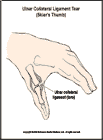
Ulnar Collateral Ligament Sprain (Skier's Thumb)
What is an ulnar collateral ligament sprain of the thumb?
A sprain is a joint injury that causes a stretch or tear in a ligament. A ligament is a strong band of tissue connecting one bone to another. An ulnar collateral ligament sprain of the thumb is a painful injury that may cause looseness of the thumb joint at the base of the thumb where it attaches to the hand.
Sprains are graded I, II, or III, depending on the severity of the sprain:
- grade I sprain: pain with minimal damage to the ligament
- grade II sprain: more ligament damage and mild looseness of the joint
- grade III sprain: complete tearing of the ligament and the joint is very loose or unstable.
How does it occur?
A sprain of the ulnar collateral ligament in the thumb is a common injury in skiing. It may occur when you fall onto your outstretched thumb, bending it back toward your arm. This stretches and injures the ulnar collateral ligament. It may also be caused by catching your thumb on your ski pole strap. It may occur in other activities when you fall onto your outstretched thumb or when your thumb gets hooked onto another player's jersey or face mask.
What are the symptoms?
You usually have pain, swelling, and tenderness at the inner part of the base of your thumb where it attaches to your hand. It may be difficult to hold an object in your hand and apply force with your thumb. Moving your thumb causes pain.
How is it diagnosed?
Your health care provider will review your symptoms, examine your thumb, and check to see if your thumb joint is loose. He or she may order an x-ray of your thumb to see if it is broken.
How is it treated?
A grade III sprain with a very loose joint requires surgery to repair the ligament. Grade I and grade II sprains may be treated with a cast, taping, or splinting so that the thumb does not move for up to 6 weeks.
Initially, the hand with the injured thumb should be kept elevated on a pillow when you are lying down or on the back of a chair or couch when you are sitting. Place ice on your thumb for 20 to 30 minutes every 3 to 4 hours for 2 to 3 days or until the pain goes away. Your health care provider may prescribe an anti-inflammatory medication or other pain medication.
When can I return to my sport or activity?
The goal of rehabilitation is to return you to your sport or activity as soon as is safely possible. If you return too soon you may worsen your injury, which could lead to permanent damage. Everyone recovers from injury at a different rate. Return to your sport or activity will be determined by how soon your thumb recovers, not by how many days or weeks it has been since your injury occurred. In general, the longer you have symptoms before you start treatment, the longer it will take to get better.
After you have sprained the ulnar collateral ligament of your thumb you may return to your activity when your injured thumb has gained full strength compared to the uninjured thumb. Swelling must be gone and you must have full range of motion.
In sports such as skiing be sure that you are able to grasp a ski pole with full strength. In sports such as baseball or tennis be sure that you are able to grasp the bat and racquet with full strength and without pain. Your health care provider may advise you to wear a thumb or wrist brace or tape your thumb before your activities.
How can I prevent an ulnar collateral ligament sprain?
Ulnar collateral ligament sprains are caused by falling onto an outstretched thumb. Many times this happens during accidents that are not preventable. However, in skiing you may be able to avoid this injury by using ski poles that do not have straps.

